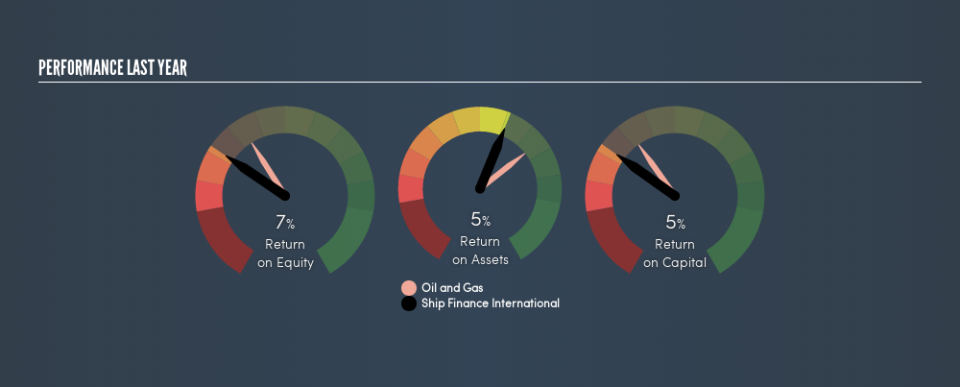Why Ship Finance International Limited’s (NYSE:SFL) Use Of Investor Capital Doesn’t Look Great

Want to participate in a short research study? Help shape the future of investing tools and you could win a $250 gift card!
Today we are going to look at Ship Finance International Limited (NYSE:SFL) to see whether it might be an attractive investment prospect. To be precise, we'll consider its Return On Capital Employed (ROCE), as that will inform our view of the quality of the business.
First up, we'll look at what ROCE is and how we calculate it. Next, we'll compare it to others in its industry. Finally, we'll look at how its current liabilities affect its ROCE.
What is Return On Capital Employed (ROCE)?
ROCE measures the 'return' (pre-tax profit) a company generates from capital employed in its business. In general, businesses with a higher ROCE are usually better quality. Ultimately, it is a useful but imperfect metric. Author Edwin Whiting says to be careful when comparing the ROCE of different businesses, since 'No two businesses are exactly alike.'
So, How Do We Calculate ROCE?
Analysts use this formula to calculate return on capital employed:
Return on Capital Employed = Earnings Before Interest and Tax (EBIT) ÷ (Total Assets - Current Liabilities)
Or for Ship Finance International:
0.055 = US$191m ÷ (US$3.8b - US$273m) (Based on the trailing twelve months to March 2019.)
So, Ship Finance International has an ROCE of 5.5%.
View our latest analysis for Ship Finance International
Is Ship Finance International's ROCE Good?
ROCE can be useful when making comparisons, such as between similar companies. In this analysis, Ship Finance International's ROCE appears meaningfully below the 7.4% average reported by the Oil and Gas industry. This could be seen as a negative, as it suggests some competitors may be employing their capital more efficiently. Independently of how Ship Finance International compares to its industry, its ROCE in absolute terms is low; especially compared to the ~2.7% available in government bonds. There are potentially more appealing investments elsewhere.
Ship Finance International's current ROCE of 5.5% is lower than 3 years ago, when the company reported a 7.8% ROCE. So investors might consider if it has had issues recently. The image below shows how Ship Finance International's ROCE compares to its industry, and you can click it to see more detail on its past growth.
Remember that this metric is backwards looking - it shows what has happened in the past, and does not accurately predict the future. Companies in cyclical industries can be difficult to understand using ROCE, as returns typically look high during boom times, and low during busts. ROCE is, after all, simply a snap shot of a single year. Remember that most companies like Ship Finance International are cyclical businesses. Since the future is so important for investors, you should check out our free report on analyst forecasts for Ship Finance International.
Do Ship Finance International's Current Liabilities Skew Its ROCE?
Liabilities, such as supplier bills and bank overdrafts, are referred to as current liabilities if they need to be paid within 12 months. The ROCE equation subtracts current liabilities from capital employed, so a company with a lot of current liabilities appears to have less capital employed, and a higher ROCE than otherwise. To check the impact of this, we calculate if a company has high current liabilities relative to its total assets.
Ship Finance International has total liabilities of US$273m and total assets of US$3.8b. Therefore its current liabilities are equivalent to approximately 7.2% of its total assets. Ship Finance International has a low level of current liabilities, which have a negligible impact on its already low ROCE.
The Bottom Line On Ship Finance International's ROCE
Nevertheless, there are potentially more attractive companies to invest in. But note: make sure you look for a great company, not just the first idea you come across. So take a peek at this free list of interesting companies with strong recent earnings growth (and a P/E ratio below 20).
I will like Ship Finance International better if I see some big insider buys. While we wait, check out this free list of growing companies with considerable, recent, insider buying.
We aim to bring you long-term focused research analysis driven by fundamental data. Note that our analysis may not factor in the latest price-sensitive company announcements or qualitative material.
If you spot an error that warrants correction, please contact the editor at editorial-team@simplywallst.com. This article by Simply Wall St is general in nature. It does not constitute a recommendation to buy or sell any stock, and does not take account of your objectives, or your financial situation. Simply Wall St has no position in the stocks mentioned. Thank you for reading.


